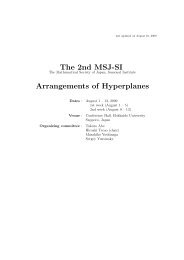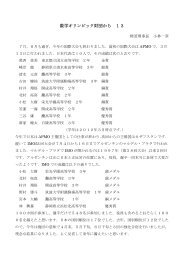Titles and Short Summaries of the Talks
Titles and Short Summaries of the Talks
Titles and Short Summaries of the Talks
You also want an ePaper? Increase the reach of your titles
YUMPU automatically turns print PDFs into web optimized ePapers that Google loves.
18 Algebra<br />
Final: 2013/2/7<br />
35 Mitsuhiro Miyazaki<br />
(Kyoto Univ. <strong>of</strong> Edu.)<br />
∗ Tensor <strong>of</strong> indeterminates <strong>and</strong> invariant <strong>the</strong>ory · · · · · · · · · · · · · · · · · · · · · 10<br />
Summary: High-dimensional array data analysis is now rapidly developing <strong>and</strong> being successfully<br />
applied in various fields. A high-dimensional array datum is called a tensor in those communities.<br />
To be precise, a d-dimensional array datum (ai1i2···id )1≤ij≤mj is called a d-tensor or an m1×· · ·×md-<br />
tensor.<br />
A 2-tensor is no o<strong>the</strong>r than a matrix. For a matrix <strong>of</strong> indeterminates, that is, a matrix whose entries<br />
are independent indeterminates, <strong>the</strong>re are many results about <strong>the</strong> action <strong>of</strong> classical groups <strong>and</strong> <strong>the</strong><br />
ring <strong>of</strong> invariants under <strong>the</strong>se actions. In this talk, we consider an m×n×2-tensor <strong>of</strong> indeterminates<br />
<strong>and</strong> <strong>the</strong> action <strong>of</strong> <strong>the</strong> product <strong>of</strong> special linear groups on <strong>the</strong> polynomial ring generated by <strong>the</strong><br />
entries <strong>of</strong> <strong>the</strong> tensor.<br />
36 Kyouko Kimura (Shizuoka Univ.) ∗ Non-vanishingness <strong>of</strong> Betti numbers <strong>of</strong> edge ideals <strong>and</strong> complete bipartite<br />
graphs · · · · · · · · · · · · · · · · · · · · · · · · · · · · · · · · · · · · · · · · · · · · · · · · · · · · 10<br />
Summary: We study <strong>the</strong> non-vanishingness <strong>of</strong> Betti numbers <strong>of</strong> edge ideals. Let G be a finite<br />
simple graph. Then we can associate an ideal I(G) with G, which is called <strong>the</strong> edge ideal <strong>of</strong> G.<br />
We show that <strong>the</strong> Betti number <strong>of</strong> I(G) does not vanish if G contains a set <strong>of</strong> complete bipartite<br />
subgraphs with some properties, one <strong>of</strong> which is related to <strong>the</strong> 3-disjointness <strong>of</strong> edges <strong>of</strong> G.<br />
37 Takao Hayami (Hokkai-Gakuen Univ.) ∗ Hochschild cohomology ring <strong>of</strong> quaternion algebras · · · · · · · · · · · · · · · · · 10<br />
Summary: We give an efficient bimodule projective resolution <strong>of</strong> <strong>the</strong> generalized quaternion Z<br />
algebra Γ. As a main result, we determine <strong>the</strong> ring structure <strong>of</strong> <strong>the</strong> Hochschild cohomology HH ∗ (Γ)<br />
by calculating <strong>the</strong> Yoneda products using this resolution.<br />
38 Kenichi Shimizu (Nagoya Univ.) ♯ On indicators <strong>of</strong> Hopf algebras · · · · · · · · · · · · · · · · · · · · · · · · · · · · · · · · · · · 15<br />
Summary: Kashina, Montgomery <strong>and</strong> Ng introduced <strong>the</strong> n-th indicator νn(H) <strong>of</strong> a finite-<br />
dimensional Hopf algebra H <strong>and</strong> showed that <strong>the</strong> indicators have some interesting properties<br />
such as <strong>the</strong> gauge invariance. I will talk about recent progress on <strong>the</strong> study <strong>of</strong> <strong>the</strong> properties <strong>of</strong> <strong>the</strong><br />
indicators, including (1) <strong>the</strong> cyclotomic integrality, (2) a formula for <strong>the</strong> opposite Hopf algebra, (3)<br />
a formula for <strong>the</strong> Drinfeld double, <strong>and</strong> (4) a relation to <strong>the</strong> quasi-exponent.<br />
39 Hiroki Sasaki (Shinshu Univ.) ♯ Cohomology rings <strong>of</strong> tame blocks · · · · · · · · · · · · · · · · · · · · · · · · · · · · · · · · 15<br />
Summary: We give a <strong>the</strong>orem concerning direct summ<strong>and</strong>s <strong>of</strong> source algebras <strong>of</strong> block ideals.<br />
We also show that <strong>the</strong> cohomology rings <strong>of</strong> tame blocks are <strong>the</strong> images <strong>of</strong> transfer maps from <strong>the</strong><br />
cohomology rings <strong>of</strong> <strong>the</strong>ir defect groups induced by direct summ<strong>and</strong>s <strong>of</strong> source algebras.<br />
40 Tsuyoshi Miezaki (Yamagata Univ.) ♯<br />
Thomas Creutzig (TU Darmstadt)<br />
Gerald Höhn (Kansas State Univ.)<br />
The McKay–Thompson series <strong>of</strong> Mathieu Moonshine modulo two · · · · 10<br />
Summary: In this note, we describe <strong>the</strong> parity <strong>of</strong> <strong>the</strong> coefficients <strong>of</strong> <strong>the</strong> McKay–Thompson series<br />
<strong>of</strong> Mathieu moonshine. As an application, we prove a conjecture <strong>of</strong> Cheng, Duncan <strong>and</strong> Harvey<br />
stated in connection with umbral moonshine for <strong>the</strong> case <strong>of</strong> Mathieu moonshine.

















